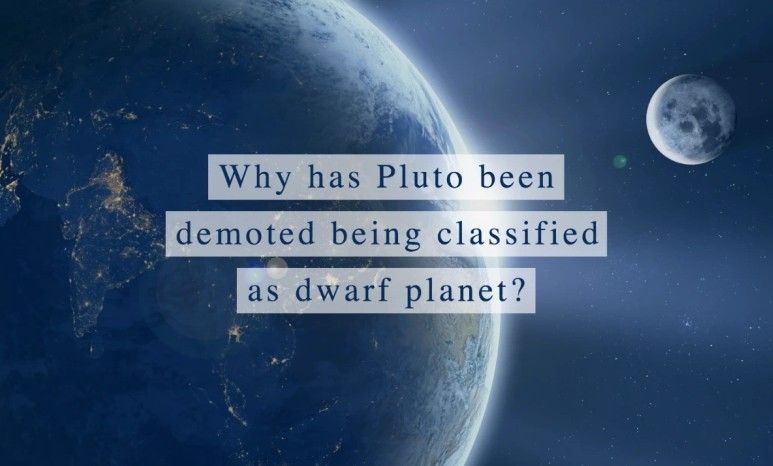Since grade school, we were taught that the Solar System has nine planets. Starting nearest the Sun and working outward, their order is the following: Mercury, Venus, Earth, Mars, Jupiter, Saturn, Uranus, Neptune, and Pluto.
Ever since the discovery of Pluto in 1930, we grew up believing that the solar system has nine planets. Until the late 1990s, when astronomers started arguing whether Pluto is a planet, then it had caused the change.
Today, Pluto is no longer included in the once Nine Planets that we know in school, heard in books, and sang in nursery rhymes. What made Pluto not to be called a planet?
The International Astronomical Union (IAU) defines a real planet as a body that circles the Sun without being another object’s satellite; it has sufficient mass to assume hydrostatic equilibrium; and has “cleared itsneighborhood” of most other orbiting bodies. (click here for more details)
This definition cleared out what should be and should not be considered a planet, and unfortunately, Pluto was among the bodies that didn’t cut and was re-classified as a dwarf planet.
Although Pluto met the first two of the IAU criteria, the third one proved pivotal. “Clearing the neighborhood” means that the planet has to be thedominant gravitational body in their orbit around the Sun. Also, no other bodies of similar size other than its satellites or those otherwise under its gravitational influence, in its vicinity in space. (click here for more details)
Because Pluto shares its orbital neighborhood with other icy Kuiper Belt Objects, the resolution effectively stripped the distant world of a planetary designation it had held for some 76 years.
It was immediately demoted to the distinct category of “dwarf planet,”alongside Ceres, the biggest body in the asteroid belt, and other large Kuiper Belt Objects such as Eris, Quaoar, and Sedna.
With the IAU planet definition, the Kuiper Belt objects such as Eris, Haumea, and Makemake and other small, round bodies transferred into the dwarf planet category.
Ceres, which was once considered as a planet when it was discovered in 1801, was later deemed to be an asteroid. That still didn’t quite fit because it was so much larger (and rounder) than the other asteroids. In 2006, astronomers instead considered it a dwarf planet, although some like to consider it as a 10th planet. (click here for more details)
What is a Dwarf Planet?
As defined by IAU, a “dwarf planet” is a celestial body in direct orbit of the Sun that is massive enough that its shape is controlled by gravitational forces rather than mechanical forces, but has not cleared its neighboring region of other objects. Any large body that does not meet the criteria for a planet can be classified as a “dwarf planet,” which includes Pluto, which shares its orbital neighborhood with Kuiper belt objects such as the plutinos. (click here for more details)
The discovery of Pluto
A celestial body is formerly known as planet Pluto. It was discovered on February 18, 1930, by astronomer Clyde W. Tombaugh at the Lowell Observatory in Flagstaff, Arizona, with contributions from William H. Pickering.
In 1906, Percival Lowell, the founder of the Lowell Observatory in Flagstaff, started an extensive project in search of a possible ninth planet, which he termed “Planet X.” After three years, Lowell and Pickering hadsuggested several possible celestial coordinates for such a planet. They searched until he died in 1916 without gathering essential data. Without him knowing, his observatory had captured Pluto’s two faint images on March 19, 1915, but they were not recognized for what they were.
Meanwhile, it was not only Lowell who unknowingly photographed Pluto. There were sixteen known pre-discoveries, with the oldest from the Yerkes Observatory made August 20, 1909.
Debate on Planet’s definition
There was no unanimous decision between astronomers and planetary scientists on the definition of a planet. To some, the classification seemed to be a scheme for limiting the number of planets, but to others, the terms were unclearly and incompletely defined.
There is only one simple goal: to define a planet as a natural object in space that is massive enough for gravity to make it approximately spherical. But there were objections from some scientists as it does not consider the degree of measurable roundness needed for an object to be considered spherical. It is even challenging to determine the shapes of some distant objects accurately.
Others argue that the location of the object and its composition should also matter. There should not be a concern whether or not an object sweeps up or scatters away its immediate neighbors, or holds them in stable orbits. And the debate continues. (click here for more details)

